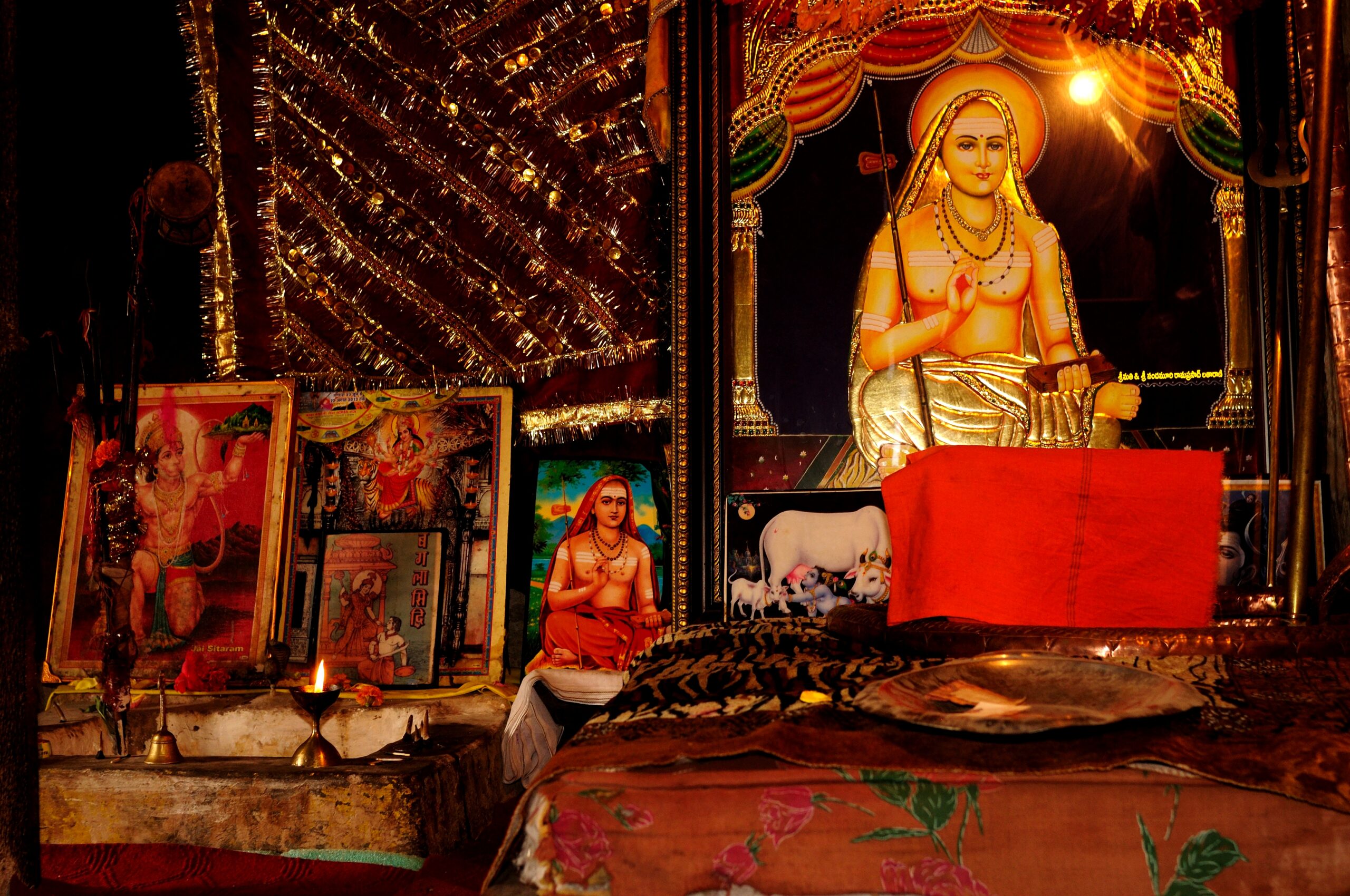Written By: professor Meenakshi Kilam
Perched gracefully upon the hill that bears its name, gazing over the shimmering expanse of Dal Lake and the undulating landscape of Srinagar, the Shankaracharya Temple stands as one of the most luminous symbols of Kashmir’s spiritual inheritance. It rises as a thought carved in stone, austere and serene, yet filled with an eternal pulse that seems to echo through the centuries. To the traveler who looks upon it from afar, it is an architectural marvel, a silent watcher over the city’s beauty. To the pilgrim who ascends its steep path, it is an inner journey, a movement of the spirit from the mortal plain to the realm of the divine.

This ancient shrine is far more than a monument of devotion. It is a mirror to the philosophical, cultural, and mystical temperament of Kashmir, a land whose mountains and rivers have long been the dwelling place of saints, scholars, and seekers. The Shankaracharya Temple, dedicated to Lord Shiva, embodies the spirit of Sanatana Dharma in its most elevated form, while also serving as a bridge between diverse strands of Indian thought. The temple’s story is at once historical and mythical, architectural and metaphysical, rooted in the earth yet aspiring to the infinite.
The origins of the temple reach deep into antiquity. Though the current structure is generally dated to around the ninth century of the Common Era, the site itself has likely been a seat of worship for much longer, perhaps even as early as 200 BCE. It is believed that ascetics who performed their meditations here revered this hill, known in ancient times as Gopadri, as a sacred space. Over the centuries, it has been called by many names. In Persian and Arabic chronicles, it appears as Takht-e-Suleiman, the Throne of Solomon, a name that captures the valley’s instinct for inclusiveness, where different traditions found echoes rather than contradictions.
It was during the great spiritual odyssey of Adi Shankaracharya, the philosopher-saint of the eighth century, that this site attained its enduring sanctity in the Hindu imagination. Shankara, who journeyed across India to revive the doctrine of Advaita Vedanta, the philosophy of non-dualism, is said to have meditated on this hill. Here he experienced the stillness that reveals the unity of all existence, the truth that the individual soul and the cosmic soul are one. The temple later came to be known by his name, as a tribute to that towering intellect and luminous consciousness that saw divinity everywhere. Through his visit, Kashmir became not just a geographical point on his map of pilgrimage but a spiritual summit in the geography of Indian realization.
The temple that stands today is simple in form yet grand in suggestion. Built of stone, it rises on a circular base, its walls thick and solid, and its sanctum quiet and small. Inside is a Shiva Lingam, self-manifested according to belief, around which the air seems to hum with an ancient vibration. The structure is a model of early Kashmiri temple architecture, marked by restraint and strength rather than ornamentation. Its beauty lies in its austerity, in the way it directs attention inward. The climb to the temple is itself a ritual. The steps are many, cut from rock and lined with the patience of centuries. As one ascends, the valley opens below like a vast mandala of earth and water. Each step feels symbolic, as though the physical effort is also a purification of thought, an ascent of consciousness. At the top, when the pilgrim finally turns to see the world spread out beneath, it feels as though both body and soul have risen together.

The Shankaracharya Temple is a shrine to Lord Shiva, the eternal yogi, the destroyer and transformer in the Hindu trinity. Yet its significance cannot be confined within the bounds of any single sect or theology. It stands at a crossroads of philosophies, a meeting point of Kashmir Shaivism, Advaita Vedanta, and devotional spirituality. Adi Shankaracharya’s meditation here gave it the aura of Advaita, the vision that the Absolute is one and without a second. However, the soil of Kashmir had already been fertile with another form of non-dual thought, the Shaiva monism that later came to be known as Kashmir Shaivism. The great masters Vasugupta, Utpaladeva, and Abhinavagupta, who lived and taught in this land, saw the universe itself as a manifestation of Shiva’s consciousness. To them, the human being was not separate from the divine but an expression of the same pulsating awareness. The Shankaracharya Temple, therefore, is not only a site of worship but also a symbolic point of convergence between these two profound visions of unity.
In the temple’s quietude, one can almost hear the dialogue between these traditions. The Advaitin speaks of Brahman, the Shaiva of Parama Shiva, yet both speak of one reality that transcends all duality. The pilgrim who bows before the Lingam is not merely paying homage to a god in stone but to a truth that lives beyond form: that the universe, the self, and the divine are threads in one seamless fabric. The very hill on which the temple stands seems to vibrate with this insight. Those who have meditated there often speak of an energy that is both still and alive, a sense of clarity that comes not from effort but from surrender.
To understand this temple in its fullest meaning, one must also recall the luminous idea of Sharda Peeth, the ancient temple and university dedicated to the goddess Saraswati, worshipped as Sharda in Kashmir. Located on the banks of the Kishanganga River, the Sharda Peeth was once among the greatest centers of learning in Asia. Scholars from India, Central Asia, and even China traveled there to study scripture, philosophy, grammar, logic, and science. Sharda was not merely a deity but a principle, the embodiment of divine speech and wisdom, the source from which both sacred revelation and human understanding flow.
The spirit of Sharda Peeth was one of synthesis. Knowledge and devotion were seen as two aspects of the same quest, and learning was itself a form of worship. To know the truth was to honor the divine. The goddess Sharda was the voice of consciousness itself, the vāk through which creation took form. Her temple was not a cloister for scholars but a sanctuary for seekers of all kinds. In that ancient age, Kashmir became known as Sharda Desh, the Land of Learning, where intellect and faith walked together.
The Shankaracharya Temple, in its silent grandeur, continues that tradition. It is an echo of Sharda Peeth, a reflection of the same belief that the highest worship lies in understanding, that to realize the divine is to awaken the mind and purify the heart. Both sites, though distinct in their forms, belong to the same civilizational current, one that saw the search for truth as the noblest form of human endeavor. When Adi Shankaracharya climbed this hill and meditated in solitude, he was entering that same lineage of enlightenment that Sharda Peeth represented. His Advaita Vedanta and the Sharda philosophy share the conviction that knowledge is not mere accumulation but revelation, not analysis but realization.

The phrase “Vidyaiva Moksha” — knowledge itself is liberation — could well describe the soul of both. In Sharda’s vision, the knower, the known, and knowledge are one; in Shankara’s Advaita, the self, the world, and the absolute are one. Both dissolve the walls of separation and affirm the unity of all existence. That unity, expressed through different symbols and languages, is what the Shankaracharya Temple continues to radiate.
The temple stand as a living symbol of Kashmir’s syncretic spirit for centuries that deepens the urge to binding and findings to lit the energies within.
Those cherish the metaphysical vibes of Shankarchaya or Solomon are not perceived as possession but participation with a universal kinship, divinity and superhuman virtues as Kashmir’s spiritual geography has always been capacious to include many heavens.
Through the long centuries of Kashmir’s history, the Shankaracharya Temple has endured. During the Islamic period, when many Hindu sites faced neglect, this temple somehow survived, perhaps protected by its remoteness and the reverence it commanded. Sultan Zain-ul-Abidin, known as Budshah, whose rule in the fifteenth century is remembered for tolerance and cultural patronage, is said to have supported efforts to preserve such ancient monuments. Later, the Mughals, who admired the natural beauty of the valley, also regarded the temple hill with respect. Under the Dogra Maharajas of the nineteenth century, particularly Maharaja Gulab Singh and Maharaja Ranbir Singh, restoration work was carried out to strengthen the structure and revive religious activity there.
After India’s independence, despite the turmoil that often gripped the region, the temple continued to function as an active place of worship. Today, it is under the protection of the Archaeological Survey of India, recognized not only for its religious but also for its historical and architectural significance. Pilgrims, tourists, and seekers alike climb its steps every year. For many, it is a necessary stop on the way to the Amarnath Yatra. They often arrive before dawn to watch the first rays of sunlight fall over Dal Lake, an experience that feels like witnessing the world’s first morning.
Legends still cling to the hill. Some speak of hidden chambers and secret thrones, others of energies that connect it to cosmic centers. To scholars, these are metaphors; to believers, they are living truths. Either way, they remind us that the sacred cannot be reduced to mere history. The Shankaracharya Temple is part of that timeless dialogue between myth and philosophy that has shaped the Indian imagination.
In the wider picture of Indian culture, the temple’s importance is not confined to Kashmir alone. It is part of a chain of sacred sites that mark Shankaracharya’s journey across the subcontinent. Yet among all these, this Srinagar temple holds a special place because of its position at the confluence of traditions. It unites the Advaita with the Shaiva, creating a bridge across both space and thought. In this synthesis lies the secret of its continuing vitality.
What makes the temple’s significance undiminished, indeed ever-growing, is that it represents the larger Indian capacity to integrate rather than exclude. In an age that often mistakes religion for rigidity and faith for fanaticism, the Shankaracharya Temple speaks of another kind of religiosity, one that is contemplative, inclusive, and endlessly open to understanding. Its silence is more eloquent than any sermon, its endurance more persuasive than any argument.
The spirit of Sharda Peeth still breathes through it. Both sites, separated by geography and time, are united by the same melody of wisdom. Sharda Peeth once drew scholars who sought the word of truth; the Shankaracharya Temple draws seekers who seek its silence. Both celebrate knowledge as a sacred act and regard the human mind as a temple of the divine. In their continuity, one can trace the civilizational rhythm of Kashmir itself: the fusion of intellect and intuition, learning and liberation, philosophy and poetry.
The Shankaracharya Temple also remains a living metaphor for India’s spiritual geography. Just as it stands above Srinagar, looking down upon the life of the city, so too does the idea it embodies look over the life of the nation, reminding us that our diversity is not a weakness but a song in many voices. It tells us that sacredness is not confined to temples and texts, but is alive in the meeting of hearts, in the recognition of unity behind difference.
As the sun rises over the Dal Lake and the temple’s stones glow with light, one can feel the continuity of ages in a single moment. The chants of ancient Shaiva sages, the meditations of Adi Shankaracharya, the prayers of unknown pilgrims, and the murmured legends of Solomon all seem to blend into a single sound. That sound is the voice of Kashmir itself, the voice of a civilization that has always sought harmony amidst change.

To visit the Shankaracharya Temple, therefore, is not only to see a monument of stone but to encounter a living idea. It is to walk into a space where faith and philosophy are inseparable, where history becomes prayer and prayer becomes thought. It is to feel, if only for a moment, that knowledge and devotion are one, and that truth, like the light that touches the temple each morning, belongs to everyone.
No matter how the world outside changes, the temple’s presence will not fade. Its meaning deepens with time, for it speaks to something beyond time. It reminds us that civilizations are not sustained by wealth or power but by vision, by the courage to see the divine in all. The Shankaracharya Temple continues to shine as that vision, as the radiant crown of Kashmir, the enduring flame of Sharda, and the living heart of India’s spiritual imagination.
| You are the Self, the infinite Being, the pure, unchanging Consciousness, which pervades everything. Your nature is bliss and your glory is without stain. Because you identify yourself with the ego, you are tied to birth and death. Your bondage has no other cause. (Adi Shankaracharya) Shankara quote, Hinduism Vivekachudamani; Prahhavananda, 1947, p.9 |
Utterly destroy the ego. Control the many waves of distraction which it raises in the mind. Discern the Reality and realize “I am That.”
You are pure Consciousness, the witness of all experiences. Your real nature is joy. Cease this very moment to identify yourself with the ego.
(Adi Shankaracharya) Shankara quote, Hinduism
Vivekachudamani; Prahhavananda, 1947, p.97
Who is free from sin?
One who chants the name of God.
(Adi Shankaracharya) Shankara quote, Hinduism
Prabhavananda, Swami, and isherwood, Christopher, trans. Shankara’s Crest-Jewel of Discrimination. New York: New American Library, 194 7, pp. 119-127.








